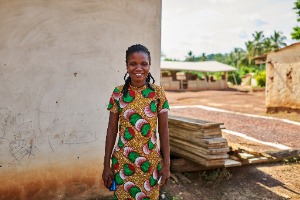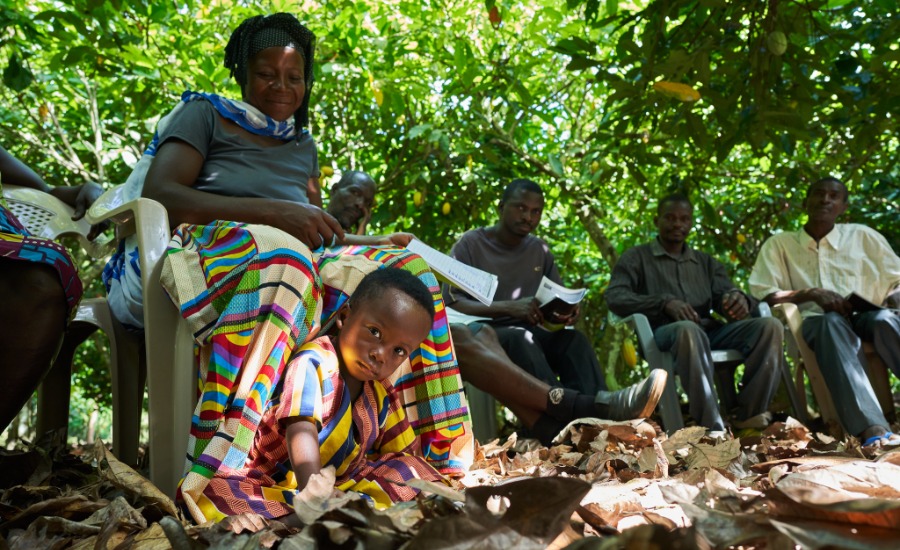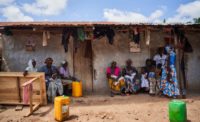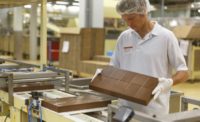Editor’s note: Barry Callebaut recently hosted a press trip in Ghana, offering members of the media, including Candy Industry, an up-close look at its efforts there under the Forever Chocolate program. This article is part one in the three-part series.
The other parts in the series include:
Part 2: Barry Callebaut wants to talk about cocoa farmer poverty.
Part 3: Barry Callebaut wants to talk about climate change.
In the last year, Barry Callebaut has found 3,867 cases of child labor in its global supply chain. And of those, 2,333 — 60 percent — are in the process of being remediated.
Those aren't the kind of statistics most chocolate companies are willing to lay out so bluntly. But there it is, right in the company’s Forever Chocolate Progress report for 2018-2019.
And they’re not worried about people seeing the number — in fact, quite the opposite according to Nicko Debenham, VP head of sustainability for Barry Callebaut.
“It’s not something that we’re trying to hide, it’s something that we’re trying to put on the table, and say, ‘We monitored our farmers, and we found these children working on the farms and we are going to remediate that situation,’” he explains.
It’s not something that we’re trying to hide, it’s something that we’re trying to put on the table, and say, ‘We monitored our farmers, and we found these children working on the farms and we are going to remediate that situation.'
– Nicko Debenham, VP head of sustainability for Barry Callebaut.
But now that everyone knows how exactly widespread the problem of child labor is in cocoa, the real problem comes to light — how do you actually solve it?
The chocolate industry has been trying for decades to eliminate child labor, and so far, it hasn’t been successful. The goal posts have routinely moved — first 2010, then 2015, then 2020, and now 2025.
And today, it’s estimated that 2 million children are working on cocoa farms in Ivory Coast and Ghana. So it’s not a small problem.
“Child labor still exists in the cocoa supply chain, despite all of the work that has been done by numerous partners throughout the industry consistently fighting its occurrence,” Debenham says. “That’s the hard truth. We admit we have to learn a lot about this complex and challenging problem.”
For a number of reasons, it’s not as simple as just telling farmers not to let their children work on the farm. And it’s not even as simple as paying the farmers more for the cocoa. Pricing is dictated by the cocoa futures market, which Barry Callebaut has no control over.
Before the industry can address child labor, though, let’s take a step back. What exactly is child labor? Does having your toddler walk around the cocoa field with you count? (No). Does introducing your teenager to the family cocoa farming business count? (Probably not).
It turns out there is a very specific definition from the International Labour Organization run by the United Nations.
“Child labor” is defined as: Work that deprives children of their childhood, their potential and their dignity, interferes with their schooling and is harmful to their physical and mental development. Activities such as carrying heavy loads or using chemicals are considered unacceptable forms of child labor because they are physically dangerous for children.”
So when Barry Callebaut talks about its work to end child labor, that’s what it’s referring to.
And it’s hopeful it will finally be able to reach the ultimate goal — complete eradication of child labor in its supply chain.
The company recently sponsored a press trip to Ghana so that media outlets, including Candy Industry, could see first-hand how Barry Callebaut is working to eliminate child labor. It’s a massive undertaking that involves lifting farmers out of poverty, working with local growing communities, and even purchasing a licensed buying company in the country.
Specifically, Barry Callebaut has dubbed its efforts “Forever Chocolate.” It’s the commitment the company made in November 2016 to work toward four specific goals, including:
1. Zero child labor: By 2025 we will eradicate child labor from our supply chain
2. Thriving Nature: By 2025 we will be carbon and forest positive
3. Prospering Farmer: By 2025 more than 500,000 cocoa farmers in our supply chain will have been lifted out of poverty
4. Sustainable chocolate: By 2025 we will have 100 percent sustainable ingredients in all of our products.
“It’s a movement to change the whole chocolate industry,” Debenham says. “We’re not trying to do this on our own. We’re trying to do it with our peers, we’re trying to do this with the governments, the donor communities, the NGOs, our critics, [the media]. And that’s really the mission that we’ve set ourselves.”
Barry Callebaut is the world’s leading manufacturer of high-quality chocolate and cocoa products — and its chocolate is in a fourth of all consumer cocoa and chocolate products. So what they do matters for the entire industry.
“We don’t have all the answers,” says Barry Callebaut’s CEO Antoine de Saint-Affrique. “There are things we still don’t know how we can resolve them. The only thing we know for sure is we cannot do it alone by ourselves. Movement is very important, and when you’re the leader in an industry, you’re in a position to trigger that movement.”
But why is Barry Callebaut so committed to trying to solve these issues? After all, it’s a long-term strategy that has the potential to hurt short-term profits.
De Saint-Affrique says it goes back to the company’s culture and ethos – and that it also makes good business sense.
“If you do only one thing, which is cocoa and chocolate [and] you want to be around in 10 years, 20 years, 30 years, there needs to be trees. There needs to be rain on the trees. There needs to be farmers who take care of the trees. And you need to do your job in a way that is sensible, because otherwise you won’t be able to serve your customers,” he says.
The press trip to Ghana offered an up-close look at some of Barry Calleabut’s efforts, as well as insight into why child labor is such a difficult problem to solve.
Located along the Gulf of Guinea and Atlantic Ocean in the subregion of West Africa, Ghana is, along with its neighboring country of Ivory Coast, responsible for about 60 percent of the world’s cocoa.
Debenham spent the entire trip with the media, and it’s clear he’s passionate about all of the sustainability work Barry Callebaut is doing globally. He started with the company in May 2014 and has spent 30 years working on the cocoa value chain.
And it was his idea for Barry Callebaut to buy a licensed buying company in Ghana. Specifically, in 2015, the company bought the LBC Nyonkopa.
This was a huge move for the company, and it was the only way to have direct access to the cocoa farmers, which in turn, gives them the opportunity to directly impact them.
So what is an LBC? Cocoa in Ghana and Ivory Coast is not sold directly from the farmers to the ingredient companies. Instead, cocoa is sold from the farmers to an LBC and then from the LBC to the government. The suppliers then buy all the cocoa directly from a governmental organization — in Ghana, that governmental organization is called the Ghana Cocoa Board (COCOBOD).
Then, the Cocoa Board sells that cocoa to ingredient companies like Barry Callebaut. It’s a layered process, and it doesn’t happen in other cocoa-growing countries like Brazil and Ecuador. Because of this process, the cocoa farmers only get 70 percent of the final price per ton of cocoa in Ghana and Ivory Coast.
The advantage of the Cocoa Board though is that it oversees quality control, sales and marketing.
Most consumers have no idea that their chocolate comes from beans, much less that a licensed buying company is the only way a chocolate supplier can interact with farmers in Ghana. In fact, most consumers don’t even know that most of the world’s chocolate comes from suppliers like Barry Callebaut.
However, what more and more consumers are aware of is the child labor in the supply chain. And while consumer-facing brands such as Hershey and Mars typically face the most heat on those issues, those companies in turn look to Barry Callebaut to fix them.
But how do you take on such massive problems? Well, it starts with changing what wasn’t working.
'What got us here is not going to get us there.’ In other words, we can’t just hit re-play on what other people have done and perhaps even what we’ve done in the past. It’s got to be done in a new way.
– Nicko Debenham, VP head of sustainability for Barry Callebaut.
“'What got us here is not going to get us there.’ In other words, we can’t just hit re-play on what other people have done and perhaps even what we’ve done in the past. It’s got to be done in a new way,” Debenham explains. “And if we’re going to achieve the targets...we have to do this at scale. This is not a little program on the side, this is the whole business.”
Just a quick look though Candy Industry’s archives highlights how different Barry Callebaut’s approach is now. In 2013, for example, the company partnered with Hershey to build a single school in the Ivory Coast. The rural school was expected to provide “educational facilities and nutrition and health support for more than 150 children.”
While projects like that can help one community, Barry Callebaut emphasizes a different approach now — it focuses on its strengths while allowing entities like the government and NGOs to focus on theirs.
Barry Callebaut doesn’t have the resources or the know-how to go into a country and build every community a new school, and they couldn’t possibly pave every road in Ghana. So, instead they partner with other stakeholders to accomplish these goals.
“You can’t build a school if there are no teachers in the school. Or if there are no nurses in the school. If it’s a secondary school, if there are no amenities that are separate for ladies and for men. You don’t resolve anything,” de Saint-Affrique explains. “There are places where we can have impact…We draw the focus on trying to change structurally things where we can have a real impact on. Rather than doing a small thing here and a small thing there, which are much better done [by others]. For schools, the government does that very well.”
That doesn’t mean they’ve stopped doing those things all together. While on the press trip, we visited a small village near Kumasi where Barry Callebaut had recently installed a well. Before they had put it in place, the villagers had to walk a mile every day for water.
“We would normally have expected this community to have a well built by this government, but it obviously got to the point where it just was never going to happen,” Debenham explains. “So we step in and do it. But you wouldn’t normally want to do that, because it’s not our responsibility. But we will do it if nobody is going to do it.”
Finding the balance between helping communities and finding solutions to massive scale issues has been difficult for Barry Callebaut to navigate, and there’s been a lot of trial and error.
But consumers have had little patience for companies like Barry Callebaut trying to deflect the blame for things like child labor and farmer poverty by saying they had little control over them.
“How far do we go in the sense of the responsibility of the company versus the responsibility of the government?” Debenham asks. “We’re trying to do it by raising awareness and working with people in government to support them to take up their responsibility for their side of the challenge by helping the community make the necessary interventions with the government.”
The only way to really tackle child labor on a massive scale is to foster cultural changes.
“You try to address it at a much deeper level than what was done in the past. You need to address it at the community level,” de Saint-Affrique says.
He says the goal is to help shift cultural attitudes so that child labor is seen as unacceptable – and that can only be done at the community level.
“A kid that is not at school in Indonesia is socially unacceptable. So people on the side of the street would see a kid that is not at school, point at the kid and say, ‘Why are you not [in school]?” de Saint-Affrique explains.
But that doesn’t happen in Ghana — at least not yet.
“I think now we are thinking much more in terms of root cause and how to tackle it. There is no simplistic solution to it,” he explains.
One way they’re working to change those root causes is by helping to set up Child Labor Committees. The groups are made up of volunteers elected by the community. They then do a risk assessment for the children in the village and see which ones are at the highest risk of child labor. They look at things like whether both parents are alive and whether the mom lives in the home.
 Twenty-five-year-old Ellen Tawiah (pictured) is a member of the Child Protection Committee in the village of Gyadam. She says her village has 460 total kids, and of those they found that 100 were at risk of child labor. But they’ve been able to mitigate that risk for about 20 of the kids.
Twenty-five-year-old Ellen Tawiah (pictured) is a member of the Child Protection Committee in the village of Gyadam. She says her village has 460 total kids, and of those they found that 100 were at risk of child labor. But they’ve been able to mitigate that risk for about 20 of the kids.
Sometimes mitigating that risk is as simple as getting a school uniform for a child, because he may be avoiding school because of a lack of a uniform and that makes them more likely to work in the cocoa fields. Other times it’s more complicated. For example, the committee also looks to see whether both parents are alive and living at home when making risk assessments.
In addition to work on the ground, Barry Callebaut has invested heavily in research and data to help navigate these issues.
Specifically, the company’s child labor monitoring system, which is a partnership with the International Cocoa Initiatives, worked with more than 5,000 farmers in Ivory Coast in 2016. As part of the program, facilitators on the ground work with communities to track and remediate child labor and pinpoint the factors that contribute to it.
“We are using the Census data to create heat maps where we can identity where there is more likely to be child labor which then enables us to prioritize those communities,” Debenham says. “And at the moment we are seeing about a 60 percent accuracy, which is pretty huge. It means that we can prioritize hot spot areas. And go and work in those areas rather than just doing a blanket approach.”
Directly addressing child labor will only go so far, though, which is partly why Forever Chocolate has a wide range of goals. And the results for each one impacts the others.
Read on to see how Barry Callebaut also is working to address farmer poverty and climate change.
Part 2: Barry Callebaut wants to talk about cocoa farmer poverty








